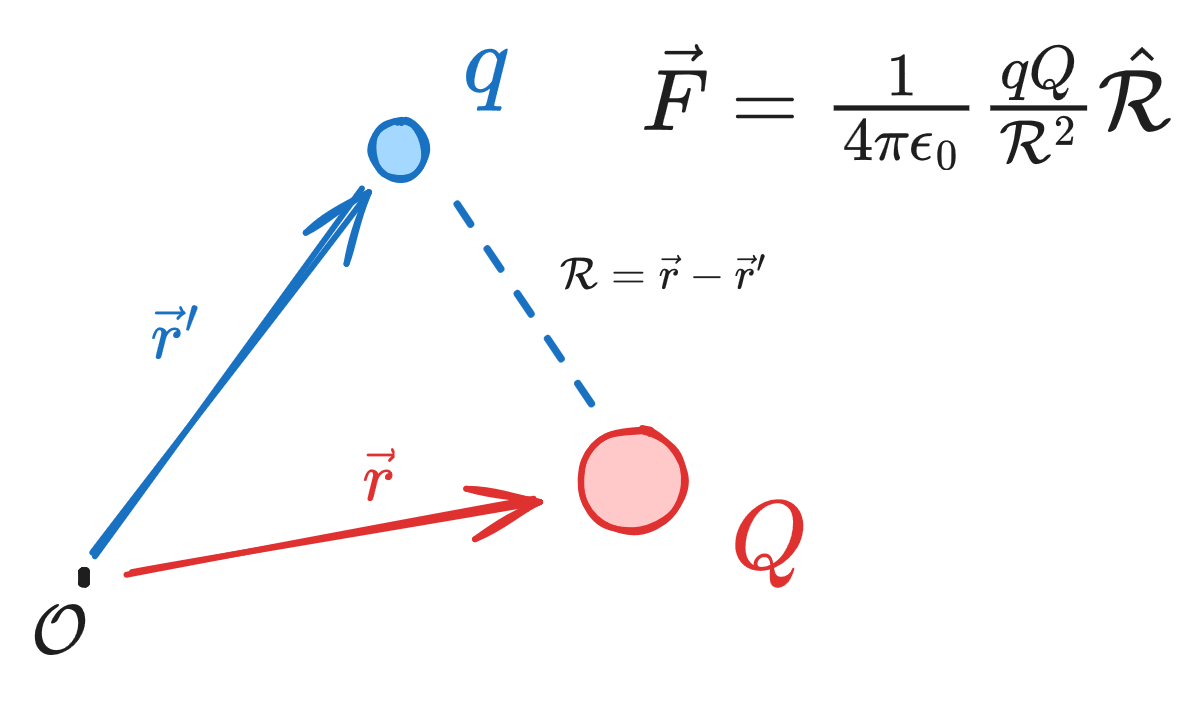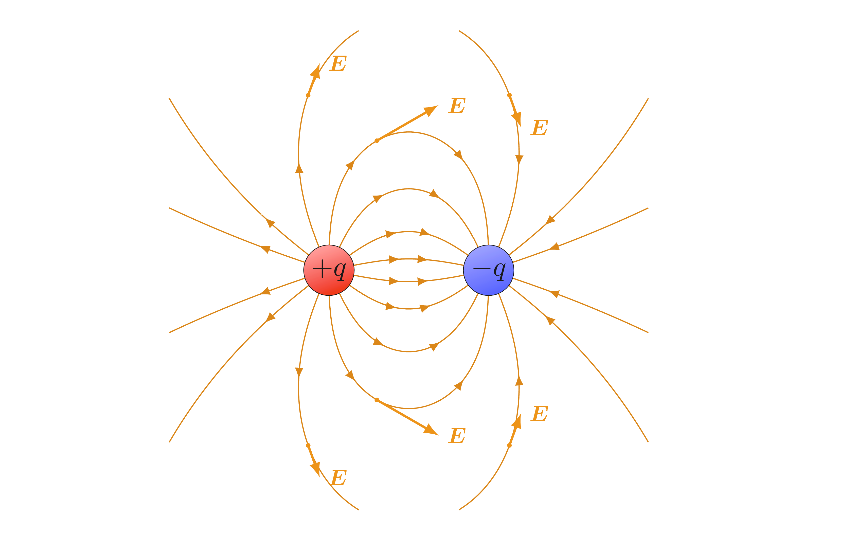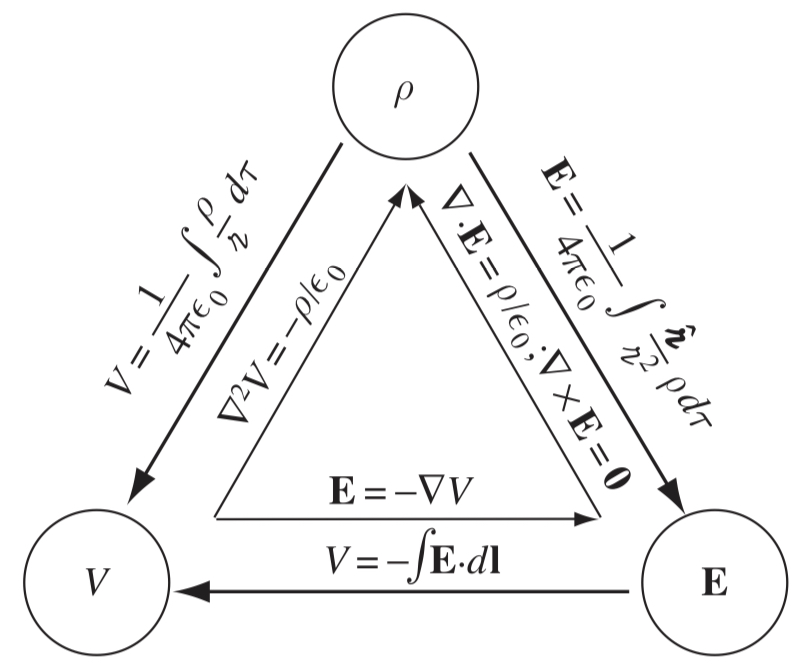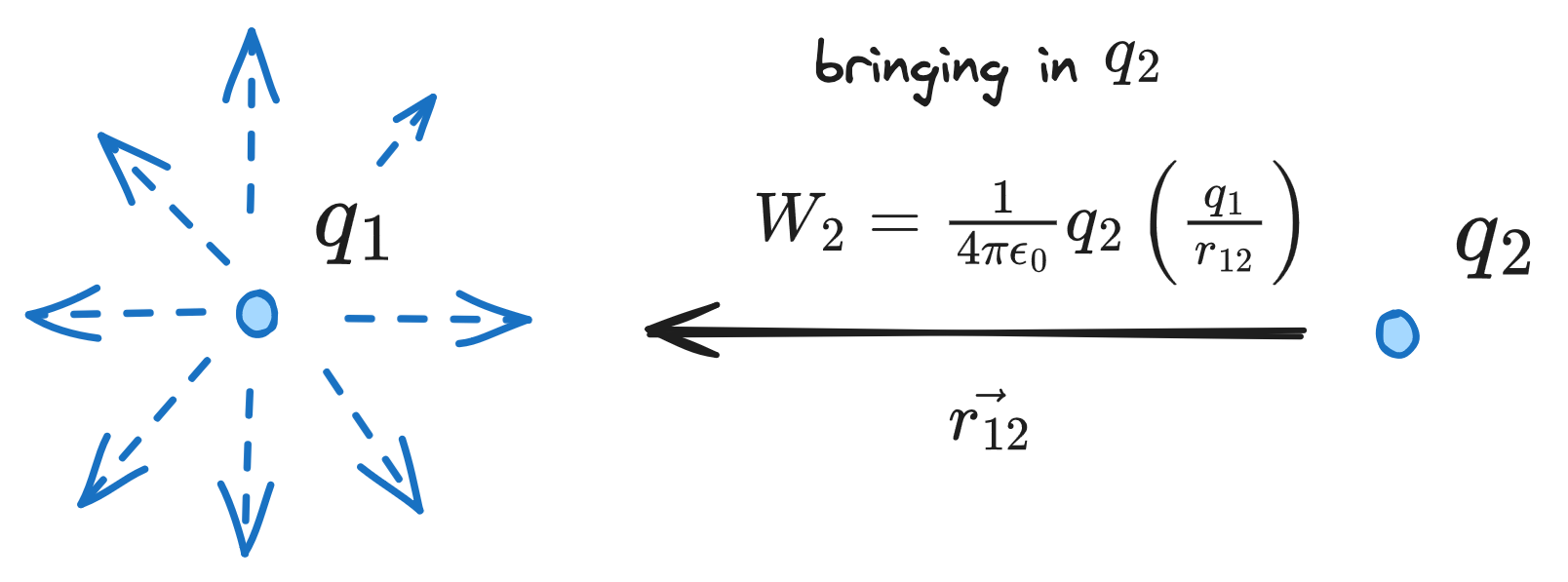Chapter 2 - Electrostatics
Reference "Introduction to Electrodynamics" by David Griffiths.
Fundamentally, electrodynamics seeks to model the interaction of some set of charges on some other charge, .
We can do this via superposition, which states the interaction between two charges is unaffected by the presence of others - i.e. , the force between and , is independent of the presence of and . We can then sum up the forces to get our net force on :
In an electrostatic system (no moving charges as opposed to an electrodynamic system), the forces can be calculated via Coulomb's law.
Coulomb's Law
Electrostatics simply takes into account distance and charge strength. Coulomb's law is
is the permittivity of free space ( and (Griffith's script-r).
in electrostatics, force increases with higher-magnitude charges, and decreases with distance.
 If we have several charges, we just sum their individual Coulomb forces as calculated above:
If we have several charges, we just sum their individual Coulomb forces as calculated above:
In shorthand, where , the electric field, is where .
The electric field is the force per unit charge - this force can only be imparted by the presence of other charges.
Continuous Charge Distributions
If we have a set of charges , then our electric field is generated from a discrete charge distribution. If, however, the charge is distributed continuously over some region, then we have a continuous charge distribution generating the -field.
 The electric field calculated as an integral over that continuous distribution:
where varies for our continuous distribution type (1D, 2D or 3D), such that:
The electric field calculated as an integral over that continuous distribution:
where varies for our continuous distribution type (1D, 2D or 3D), such that:
- Line:
- Area:
- Volume:
Regarding the vectors,
- is from the origin to test point; above a disk, this might be be .
- is from the origin to infinitesimal elements; often or .
- , .
The will usually yield two unit vectors (i.e. ). Use two separate integrals with the same element to handle.
Divergence and Curl of Electrostatic Fields
Griffiths 2.2.
Field lines are a way to visualize electric fields on a 2D or 3D medium.

where the density of field lines indicates the strength of the E-field at that location (strongest near the center in the above image). The flux of through some surface is and is a way to measure the total charge contained within a closed surface, while those outside of the surface don't affect it.

This mathematically represented by Gauss's law, which states There's also a differential version of Gauss's law (found by applying the Divergence Theorem) where is charge density:
For example: in 3D, if a point charge is at the origin then the flux of through a sphere around it is
We're only evaluating at the surface of the sphere, so is constant.
Note that Gauss's law is only useful with objects where the E-field is pointing in the same direction as elements . This requires both a symmetrical charge distribution within the object, and for the Gaussian surface to be symmetric according to one of the following:
- Spherically symmetric (concentric spheres)
- Cylindrically symmetric (coaxial cylinders)
- Plane symmetric (like a "box" that is cut in half by the plane)
The associated coordinate system is used for each.
Note: flux from external charges is ignored, since the flux entering a Gaussian surface from an external charge will be equal to the flux leaving that surface from the other side - hence, net flux from those external charges is zero.
If the object we're evaluating doesn't have perpendicular surface elements (i.e. a charge at the north pole of a sphere instead of the center), then some problems can be approached by creating another Gaussian element centered over the charge which subtends the same angle, though this can get geometrically complicated.
Divergence of
Since , then this just becomes Or, in shortform,
Curl of
For any electrostatic charge distribution, the curl of the field is always zero.
Electric Potential
Griffiths 2.3.
Electric potential is a good indicator of the "strength" of an electric field between two points, and is defined as with units .
A "natural" origin is a point infinitely far from the charge, though only when the charge distribution itself doesn't also extend to infinity.
in differential form, it's the reverse: Voltage is path-independent and only displacements matter - hence the electric potential between points and is
Poisson & Laplace Equations
Poisson's equation says If there is no charge (), Poisson's equation turns into Laplace's equation:
Voltage equations
For a point charge
is the reference point from origin, from the reference point to the infinitesimal charge (or reference point to point charge).
For a set of point charges, we can use the principle of superposition:
For a continuous distribution, and for a volume (to compute when we know ):
Note: this is similar to the formula for electric field, but is missing . is a scalar quantity, directionless.
Note on continuity
For some surface,
- The normal component of is discontinuous by some amount at a boundary.
- So, if the surface is uncharged (), is continuous across the boundary.
- The parallel component of is continuous (). Representing both, The electric potential is always continuous across any boundary (however the gradient of inherits the discontinuity in , since ).
Summary
The three "fundamentals" of electrostatics are , and , and are related by the following:

Griffith's Fig. 2.35.
Work and Energy
Griffith's 2.4.
For a conservative force, work is force times displacement. In electrostatics, our equivalent version is
More extended,
where work here is the work it takes, per unit charge, to carry a charge from to . If our reference point and we let , then
Work in a Point Charge Distribution
Imagine we had some charge - then brought in a new charge to join . Our work done would be

It would cost Then, to bring in a third charge would act against the superposition of and : ... etc. To assemble charges, we'd need a work of
Work in a Continuous Charge Distribution
For a continuous charge distribution, we use our last equation for our point charge distribution system and replace the sum with an integral .
Note: is not volume, but potential. This can be done via Gauss's law as well, see this hyperphysics article.
With a bit of mathematics, this is equivalent to
Conductors
Griffith's 2.5.
Conductors are materials in which electrons are free to roam (like cows, on an open ranch 👍). In contrast, insulators have electrons pretty much immobile and packed-together (like Monsanto farms 👎).
We can approximate metals as ideal-case conductors (though perfect conductors don't yet exist, though we're gradually coming closer) with the following attributes:
- inside a conductor - or, the induced field will cancel the external field. If an external field is applied to a conductor, free electrons will move toward the E-field until they all sit on the surface, creating a deficit of charges on the opposite surface and positively charging it.
Crucially, the net E-field is zero, so the fields must cancel inside: Charge will continue to flow until the cancellation is complete. Outside the conductor, , since the two fields don't tend to cancel.
- Charge density is zero : Since Gauss's law says , zero E-field means zero charge density in the conductor.
- Net charge resides on surface: positive and negative charges will only sit on the surface after enough time passes.
- is perpendicular to the surface: somewhat obvious, but bears mentioning.
Any dynamical system will try to minimize potential energy - the charges residing on the surface are an extension of this. It might take some time, but will eventually happen.
Induced Charges
If we hold a charge near a conductor, the conductor will move toward the charge - this is because negative charges will accumulate closer to than the "effective" charges on the far side. Force falls off by , so the conductor will be attracted to the charge.
Cavities
Let's say we have a cavity inside our conductive surface. There are two scenarios here:
Empty cavity: If the cavity has no charge, the field within the cavity is zero, regardless of the external fields applied. This is the principle of the Faraday cage.
Non-empty cavity: The charge contained by the cavity will induce an opposite charge uniformly distributed on the walls of the cavity - the only information transmitted to an external observer is the distribution of charge on the exterior wall (i.e. the magnitude of the internal E-field, or the amount of net charge contained).
Surface Charge and Force on a Conductor
Through the field inside a conductor is zero, the field immediately outside is
If we only care about the magnitude of the E-field, then .
However, the electric field is discontinuous at a surface charge, so when calculating the force per unit area (or pressure) of an E-field at the surface of a conductor, we average the E-fields above and below the surface, such that This is the outward electrostatic pressure on the surface, tending to draw the conductor into a given field, regardless of the sign of (squared away).
The pressure at this point, expressed in terms of the field just outside the surface, is
Capacitors
Put two conductors beside one another, with equal and opposite uniform net charges on one and on the other:
Since the charge density is uniform on each surface, (on the left plate) and the field between the two is
with a voltage of
in a uniform E-field.
We'll define a new term to represent the proportionality of the arrangement, capacitance: with units of Farads , usually expressed in or . The work to go from one side to the other is